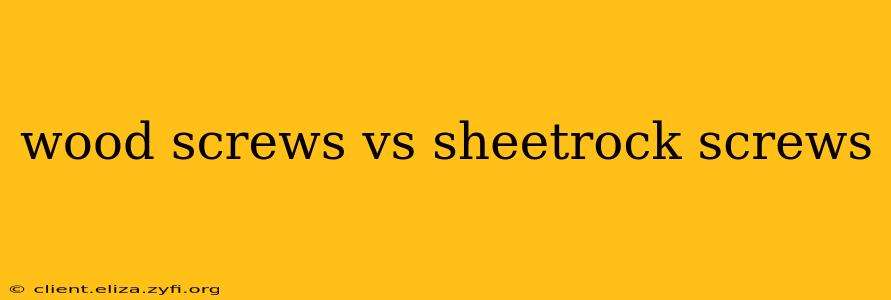Wood Screws vs. Sheetrock Screws: A Comprehensive Guide
Choosing the right screw for your project is crucial for a successful and lasting result. While both wood screws and sheetrock screws might seem similar at first glance, their designs and applications differ significantly. This guide will delve into the key distinctions between these two common fasteners, helping you select the appropriate screw for your next DIY project or professional job.
What are Wood Screws?
Wood screws are designed for joining pieces of wood together. Their sharp point and aggressive threads easily penetrate wood, creating a strong, secure hold. The threads are typically coarse and relatively deep, providing excellent gripping power. They come in a wide variety of sizes, lengths, and head styles (like Phillips, flat, oval, and round) to suit diverse woodworking needs. They are also often made of stronger materials like hardened steel to withstand significant stress.
What are Sheetrock Screws?
Sheetrock screws, also known as drywall screws, are specifically engineered for fastening drywall or sheetrock to wooden studs. Their primary difference lies in their finer threads and sharper point than wood screws. This design allows them to penetrate drywall easily without causing significant damage or cracking. The fine threads provide sufficient grip without excessive clamping force, which could damage the relatively brittle sheetrock. They also tend to have a smaller head that is designed to be easily countersunk into the sheetrock, allowing for a seamless finish.
What are the Key Differences Between Wood Screws and Sheetrock Screws?
The main differences boil down to thread type, point sharpness, and head design:
- Thread Type: Wood screws have coarse threads for a stronger grip in wood, while sheetrock screws have fine threads for a less damaging application in drywall.
- Point Sharpness: Sheetrock screws possess a sharper point for easier penetration into drywall. Wood screws have a slightly less sharp point, optimized for gripping wood fibers.
- Head Design: Sheetrock screws often have a smaller, self-countersinking head to sit flush with the wall, minimizing the need for extra finishing work. Wood screws come in a wider variety of head styles depending on the desired aesthetic and functionality.
- Material: While both can be made of steel, wood screws are often made from harder, more durable steel alloys designed to withstand greater stress and torque.
What are the Common Uses for Each Type of Screw?
-
Wood Screws: Ideal for:
- Building furniture
- Constructing wooden structures
- Joining wood components together
- Hanging heavier items on wooden surfaces
-
Sheetrock Screws: Ideal for:
- Attaching drywall to studs
- Installing trim boards on drywall
- Hanging lightweight objects on drywall
Can I Use a Wood Screw in Drywall?
While you could potentially use a wood screw in drywall, it's generally not recommended. The coarse threads can tear and damage the drywall, leaving a messy, uneven hole. Furthermore, the larger head might not sit flush, requiring extensive filling and sanding.
Can I Use a Sheetrock Screw in Wood?
Using a sheetrock screw in wood might work for thinner pieces, but it’s not ideal for applications requiring significant holding power. The fine threads don’t grip wood as effectively as coarse threads, leading to a weaker, less secure joint which could potentially strip out.
What are the potential problems of using the wrong screw type?
Using the wrong type of screw can result in several problems:
- Damage to Material: Coarse wood screws in drywall can cause cracking and tearing.
- Weak Joint: Sheetrock screws in wood may not hold securely.
- Uneven Finish: Improperly sized screw heads can leave unsightly gaps or require excessive filling and sanding.
- Structural Failure: In load-bearing applications, using an unsuitable screw could lead to failure, posing safety risks.
By understanding these key differences and choosing the right screw for the job, you can ensure a strong, reliable, and aesthetically pleasing result. Remember to always consider the material you’re working with and the intended purpose of your project.
